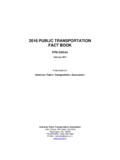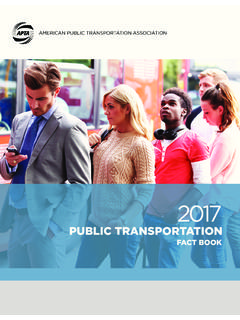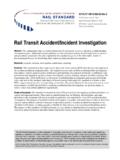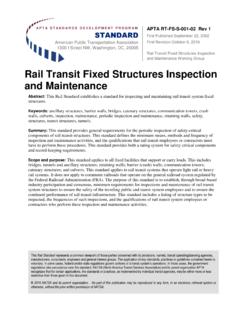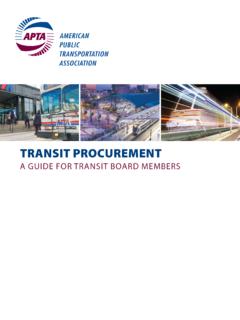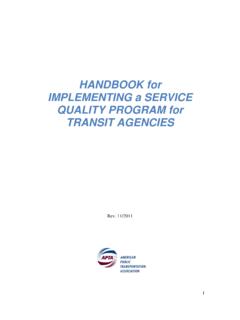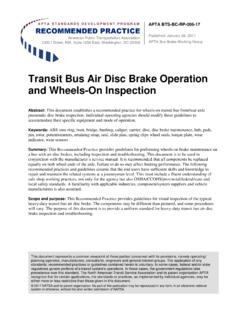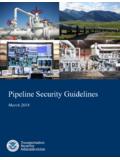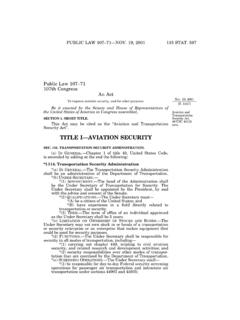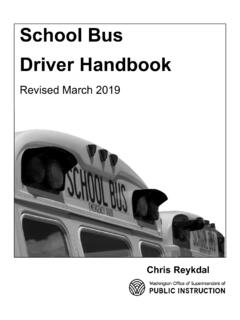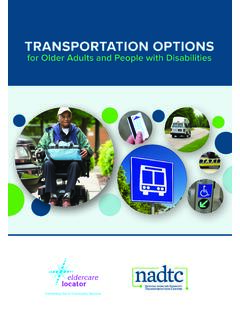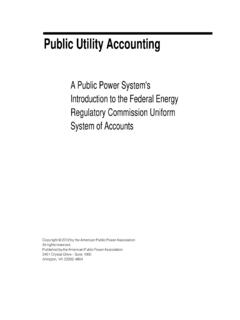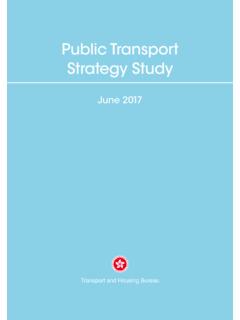Transcription of Public Transportation Reduces Greenhouse Gases and ...
1 Public Transportation Reduces Greenhouse Gases and Conserves Energy The facts are clear Public Transportation is reducing energy consumption and harmful carbon dioxide (CO2) Greenhouse gas emissions that damage the environment. Traveling by Public Transportation uses less energy and produces less pollution than comparable travel in private vehicles. To make progress in reducing our dependence on foreign oil and impacting climate change, Public Transportation must be part of the solution. The Benefits of Public Transportation Using Public Transportation Reduces Greenhouse Gases and Conserves Energy The Transportation sector produces one-third of all Greenhouse gas emissions in the United States. 1. Between 1990 and 2006, emissions in the Transportation Benefits of a Strategy that Embraces sector increased by more than 25%, representing almost half of the total national growth in Greenhouse gas emissions Public Transportation during this period.
2 Public Transportation use Reduces travel by Approximately 85% of Transportation sector emissions are private vehicles. related to the surface Transportation Those who choose to ride Public Transportation reduce An effective strategy to reduce Greenhouse gas emissions their carbon footprint and conserve energy by eliminating must include improved fuel economy, reduced carbon content travel that would have otherwise been made in a private in fuels, and reductions in the growth of vehicle miles of travel. vehicle. The result is fewer vehicle miles of travel and reduced emissions. A single person, commuting alone by car, who switches a By reducing the growth in vehicle miles of travel, 20-mile round trip commute to existing Public transporta- tion, can reduce his or her annual CO2 emissions by 4,800.
3 Easing congestion and supporting more efficient land use pounds per year, equal to a 10% reduction in all Greenhouse patterns, Public Transportation can reduce harmful CO2 Gases produced by a typical two-adult, two-car household. emissions by 37 million metric tons annually. These savings By eliminating one car and taking Public Transportation represent the beginning of Public Transportation 's potential instead of driving, a savings of up to 30% of carbon dioxide contribution to national efforts to reduce Greenhouse gas emissions can be emissions and promote energy The Private Vehicle is the largest contributor to a household's Carbon Footprint Using Public Projected increases in vehicle miles of travel will negate Transportation Reduces Household Carbon Emissions any improvements in fuel economy resulting from recently approved changes in Corporate Average Fuel Economy (CAFE) standards.
4 Increased investment in, and use of, Public Private Vehicles Electricity 25%. Transportation can mitigate this trend. Experts indicate we 55%. need to reduce total CO2 emissions to 60%-80% of 1990 Current household emissions in typical levels by two-car household Natural Gas CO2 Reduction Targets Cannot be met with 20%. Recently Enacted CAFE Standards Potential Savings 150% 30% Electricity Projected VMT 25%. 140% Potential 30% savings from eliminating one car 130% and taking Public 120% Transportation Private Vehicles 2005=100%. 110% 25%. Natural Gas 20%. 100% Projected CO2 with 90% VMT growth and new CAFE standards Source: Public Transportation 's Contribution to Greenhouse Gas 80% Reduction 4. 70%. 60%. CO2 Target 50% (on track to meet 2050 targets) Public Transportation use Reduces congestion.
5 40%. Public Transportation serves some of the most congested 2005 2010 2015 2020 2025 2030. travel corridors and regions in the country. Increased use of Projected emissions from cars and light trucks assuming newly adopted Public Transportation in these areas eases congestion; as a nationwide vehicle and fuel standards and current projected VMT growth. result, automobiles traveling in these same corridors achieve Source: Growing Cooler Report 2. greater fuel Public Transportation use is one of the most Higher densities allow for closer proximity of housing, effective actions individuals can take. employment and retail, reducing driving distances and Public Transportation offers an immediate alternative for indi- enabling communities to plan for and support alternative viduals seeking to reduce their energy use and carbon foot- travel options.
6 Prints. This action far exceeds the benefits of other energy In many central business districts, trips taken for shopping, saving household activities, such as using energy efficient dining or other non-commuting purposes are often made on light bulbs or adjusting thermostats. foot even by those who drive to work. Higher density development including transit-oriented Commuting by Public Transportation one of the development (TOD), multi-use buildings, and compact most significant actions to reduce household apartments and office space is more energy efficient and carbon emissions extends Public Transportation 's contribution by integrating it with other sectors of our economy. Taking transit to work 5000. Public Transportation Pounds of CO2 saved per year with its overarching 4000 Adjusting effects on land use, is estimated to reduce CO2.
7 Thermostat emissions by 37 million metric tons annually. and winterizing your home 3000. 2000. This indirect leverage effect of Public Transportation is esti- mated, conservatively, at three to four times the direct effect of transit service. With this leverage effect, transit is estimated 1000 Replacing lightbulbs Replacing to reduce CO2 emissions by 37 million metric tons annually. In old refrigerator addition, Public Transportation Reduces energy consumption 0 by the equivalent of billion gallons of gasoline each year, the equivalent of 320 million cars filling up almost 900,000. By taking existing Public Transportation instead of driving a car, a single person saves 4,800 pounds of CO2 per year. Source: Public times a Transportation 's Contribution to Greenhouse Gas Reduction 4.
8 Average Annual Household Savings from Using Public Transportation Public Transportation gives people energy efficient $15000. choices. Public Transportation Reduces overall Greenhouse gas emis- $12000. sions without reducing the mobility so vital to our nation's $6,251. economic health and our citizens' quality of life. $9000. The increasing cost of fuel makes driving private vehicles even more prohibitive for many. Public Transportation $6000. households save an average of $6,251 every year3 even more as the price of fuel rises. $3000. Public Transportation is essential to energy 0. efficient land use patterns. Public Transportation No-transit household Efficient land use produces results far beyond the immediate household benefit of increased use of Public Transportation .
9 It has the Transit Fare Fuel Vehicle Ownership potential to significantly change the way we live and travel, reducing our individual carbon footprints while preserving By taking Public Transportation instead of driving a car, a two-worker and enhancing our mobility. household can save $6,251 annually. Source: Public Transportation and Petroleum Savings Report 3. Public Transportation Requires Investment to Further Reduce CO2 Emissions and Conserve Energy Protect and preserve Public Transportation service where it exists today. Public Transportation ridership has increased by 30% since 1995 a growth rate more than twice that of population, and greater than vehicle miles of travel. As transit rider- ship has increased, a number of systems are struggling to maintain the quality of assets and consequently the quality and reliability of service.
10 Systems must be adequately funded to allow people who are choosing Public Transportation , more than 10 billion trips annually, to stay on Public Transportation . Expand capacity of existing Public Transportation services. In many parts of the country, Public Transportation systems are operating beyond their design capacity. With future annual ridership growth projected at annually, it will be difficult for a number of these systems to carry additional riders without significant new investment. Systems that are investing to expand capacity and attract new riders include: Charlotte, NC, recently opened its first modern light rail system. The New York Metropolitan Transportation Authority is in the process of constructing the Second Avenue Subway Line to relieve severe crowding.
